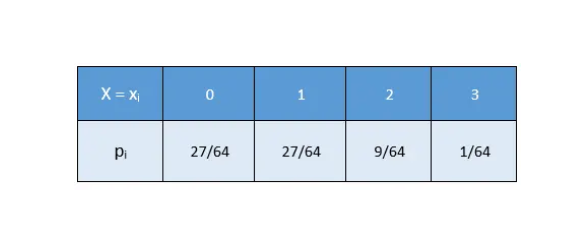Probability Distribution
Random Variable Let S be the sample space associated with a given random experiment.
A real-valued function X which assigns a unique real number X(w) to each w ∈ S, is called a random variable. A random variable that can assume only a finite number of values is called a discrete random variable.
Example: Suppose that a coin is tossed twice.
Then, sample space S = {TT, HT, TH, HH}
Consider a real-valued function X on S, defined by X: S → R: X(w) = number of heads in w, for all w ∈ S.
Then, X is a random variable such that X(TT) = 0, X(HT) = 1, X(TH) = 1 and X(HH) = 2.
Clearly, range (X) = {0,1, 2}.
Read and Learn More WBCHSE Solutions For Class 12 Maths
Probability Distribution of a Random Variable: A description giving the values of a random variable along with the corresponding probabilities is called the probability distribution of the random variable.
If a random variable X takes the values x1,x2, …,xn with respective probabilities p1, p2,……,pn then the probability distribution of X is given by
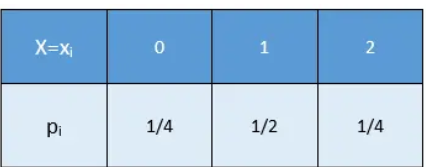
Remark: The above probability distribution of X is defined only when
- each pi ≥0
- \(\sum_{i=1}^n p_i=1\)
Mean and Variance of Random Variables
Let a random variable X assume values x1, x2,… ,xn with probabilities p1, p2,…..,pn respectively such that each pi ≥ 0 and \(\sum_{i=1}^n p_i=1 .\). Then mean of X, denoted by μ [or expected value of X, denoted by E(X)], is defined as
∴ \(\mu=E(X)=\sum_{i=1}^n x_i p_i\)
And, the variance, denoted by σ², is defined as \(\sigma^2=\left(\Sigma x_i^2 p_i-\mu^2\right)\)
Standard deviation, σ is given by \(\sigma=\sqrt{\text { variance }}.\)
Probability Distribution Solved Examples
Example 1. Find the mean, variance, and standard deviation of the number of tails in two tosses of a coin.
Solution:

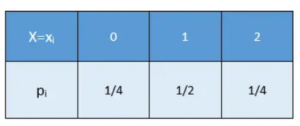
∴ mean, \(\mu =\Sigma x_i p_i=\left(0 \times \frac{1}{4}\right)+\left(1 \times \frac{1}{2}\right)+\left(2 \times \frac{1}{4}\right)=1\)
Variance, \(\sigma^2=\Sigma x_i^2 p_i-\mu^2\)
= \(\left[\left(0 \times \frac{1}{4}\right)+\left(1 \times \frac{1}{2}\right)+\left(4 \times \frac{1}{4}\right)\right]-1^2\) = \(\frac{1}{2}\) .
Standard deviation, \(\sigma=\frac{1}{\sqrt{2}} \times \frac{\sqrt{2}}{\sqrt{2}}=\frac{\sqrt{2}}{2}=\frac{1.414}{2}=0.707\).
Example 2. Find the mean, variance, and standard deviation of the number of heads when three coins are tossed.
Solution:
Here, S = [TTT, TTH, THT, HTT, THH, HFH, HHT, HHH).
∴ n(S) = 8.
So, every single outcome has a probability 1/8
Let X = number of heads in tossing three coins.
The number of heads may be 0,1,2, or 3.
So, the possible values of X are 0,1,2,3.
P(X = 0) = P(getting no head) = P(TTT) = \(\frac{1}{8}\)
P(X = 1) = P(getting 1 head) = P(TTH or THT or HTT) = \(\frac{3}{8}\)
P(X = 2) = P( getting 2 heads) = P(THH, HTH, HHT) = \(\frac{3}{8}\)
P(X = 3) = P(getting 3 heads) = P(HHH) = \(\frac{1}{8}\)
Thus, we have the following probability distribution:

∴ mean \(\mu=\Sigma x_i p_i=\left(0 \times \frac{1}{8}\right)+\left(1 \times \frac{3}{8}\right)+\left(2 \times \frac{3}{8}\right)+\left(3 \times \frac{1}{8}\right)=\frac{3}{2}\)
Variance, \(\sigma^2=\Sigma x_i^2 p_i-\mu^2\)
= \(\left[\left(0 \times \frac{1}{8}\right)+\left(1 \times \frac{3}{8}\right)+\left(4 \times \frac{3}{8}\right)+\left(9 \times \frac{1}{8}\right)-\frac{9}{4}\right]=\frac{3}{4}\).
Standard deviation, \(\sigma=\frac{\sqrt{3}}{2}\).
Example 3. A die is tossed once. If the random variable X is defined as X = 1, if the die results in an even number, X = 0, if the die results in an odd number then find the mean and variance of X.
Solution:
In tossing a die once, the sample space is given by S = {1,2,3,4,5,6}.
∴ P(getting an even number) = \(\frac{3}{6}\) = \(\frac{1}{2}\)
P(getting an odd number) = \(\frac{3}{6}\) = \(\frac{1}{2}\)
As given, X takes the value 0 or 1.
P(X = 0) = P(getting an odd number) = \(\frac{1}{2}\)
P(X = 1) = P(getting an even number) = \(\frac{1}{2}\)
Thus, the probability distribution of X is given by
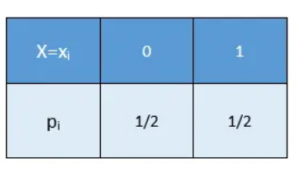
∴ mean, \(\mu=\Sigma x_i p_i=\left(0 \times \frac{1}{2}\right)+\left(1 \times \frac{1}{2}\right)=\frac{1}{2}\)
Variance, \(\sigma^2=\Sigma x_i^2 p_i-\mu^2\)
= \(\left(0 \times \frac{1}{2}\right)+\left(1 \times \frac{1}{2}\right)-\left(\frac{1}{2}\right)^2=\left(\frac{1}{2}-\frac{1}{4}\right)=\frac{1}{4}\)
Example 4. Find the mean, variance, and standard deviation of the number of sixes in two tosses of a die.
Solution:
In a single toss, we have a probability of getting a six = \(\frac{1}{6}\), and
Probability of getting a non-six = (1-\(\frac{1}{6}\)) = \(\frac{5}{6}\)
Let X denote the number of sixes in two tosses.
Then, clearly X can assume the value 0,1, or 2.
P(X = 0) = P[(non-six in the 1st draw) and (non-six in the 2nd draw)]
= P(non-six in the 1st draw) x P(non-six in the 2nd draw)
= (\(\frac{5}{6}\)x\(\frac{5}{6}\) = \(\frac{25}{36}\)
P(X=1)= P[(six in the 1st draw and non-six in the 2nd draw) or (non-six in the 1st draw and six in the 2nd draw)]
= P(six in the 1st draw and non-six in the 2nd draw) + P(non-six in the 1st draw and six in the 2nd draw)
= \(\left(\frac{1}{6} \times \frac{5}{6}\right)+\left(\frac{5}{6} \times \frac{1}{6}\right)=\left(\frac{5}{36}+\frac{5}{36}\right)=\frac{10}{36}=\frac{5}{18}\)
P(X = 2) = P[six in the 1st draw and six in the 2nd draw]
= P(six in the 1st draw) x P(six in the 2nd draw)
= \(\left(\frac{1}{6} \times \frac{1}{6}\right)=\frac{1}{36}\)
Hence, the probability distribution is given by
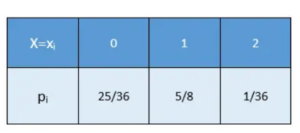
∴ mean, \(\mu=\Sigma x_i p_i=\left(0 \times \frac{25}{36}\right)+\left(1 \times \frac{5}{18}\right)+\left(2 \times \frac{1}{36}\right)=\frac{6}{18}=\frac{1}{3}\).
Variance, \(\sigma^2=\Sigma x_i^2 p_i-\mu^2\)
= \(\left[\left(0 \times \frac{25}{36}\right)+\left(1 \times \frac{5}{18}\right)+\left(4 \times \frac{1}{36}\right)-\frac{1}{9}\right]=\frac{5}{18}\).
Standard deviation, \(\sigma=\sqrt{\frac{5}{18}}=\frac{1}{3} \cdot \sqrt{\frac{5}{2}}\).
Example 5. Two cards are drawn successively with replacement from a well-shuffled pack of 52 cards. Find the mean and variance of the number of kings.
Solution:
Let X be the random variable. Then,
X = number of kings obtained in two draws.
Clearly, X can assume the value 0,1 or 2.
P(drawing a king) = \(\frac{4}{52}\) = \(\frac{1}{13}\)
P(not drawing a king) = (1-\(\frac{1}{13}\)) = \(\frac{12}{13}\)
P(X = 0) = P(not a king in the 1st draw and not a king in the 2nd draw)
= \(\left(\frac{12}{13} \times \frac{12}{13}\right)=\frac{144}{169}\).
P(X = 1) = P(a king in the 1st draw and not a king in the 2nd draw)
or P(not a king in the 1st draw and a king in the 2nd
draw)
= \(\left(\frac{1}{13} \times \frac{12}{13}+\frac{12}{13} \times \frac{1}{13}\right)=\frac{24}{169}\)
P(X = 2) = P(a king in the 1st draw and a king in the 2nd draw)
= \(\left(\frac{1}{13} \times \frac{1}{13}\right)=\frac{1}{169}\)
Hence, the probability distribution is given by
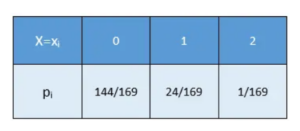
∴ mean, \(\mu=\Sigma x_i p_i=\left(0 \times \frac{144}{169}\right)+\left(1 \times \frac{24}{169}\right)+\left(2 \times \frac{1}{169}\right)=\frac{2}{13} \text {. }\)
Variance, \(\sigma^2=\Sigma x_i^2 p_i-\mu^2\)
= \(\left[\left(0 \times \frac{144}{169}\right)+\left(1 \times \frac{24}{169}\right)+\left(4 \times \frac{1}{169}\right)-\frac{4}{169}\right]=\frac{24}{169}\)
Example 6. Two cards are drawn simultaneously (or successively without replacement) from a well-shuffled pack of 52 cards. Find the mean and variance of the number of aces.
Solution:
Let X be the random variable.
Then, X denotes the number of aces in a draw of 2 cards.
∴ X can assume the value 0,1 or 2.
Number of ways of drawing 2 cards out of 52 = C(52,2).
P(X = 0) = P(both non-aces, i.e., 2 non-aces out of 48)
= \(\frac{{ }^{48} C_2}{{ }^{52} C_2}=\left(\frac{48 \times 47}{2 \times 1} \times \frac{2}{52 \times 51}\right)=\frac{188}{221}\)
P(X=1)= \(P[(\text { one ace out of } 4) \text { and (one non-ace out of } 48)]\)
= \(\frac{{ }^4 C_1 \times{ }^{48} C_1}{{ }^{52} C_2}=\left(\frac{4 \times 48}{52 \times 51} \times 2\right)=\frac{32}{221}\)
P(X=2)= \(P(\text { both aces })=\frac{{ }^4 C_2}{{ }^{52} C_2}=\left(\frac{4 \times 3}{2 \times 1} \times \frac{2 \times 1}{52 \times 51}\right)=\frac{1}{221}\)
Thus, we have the following probability distribution:
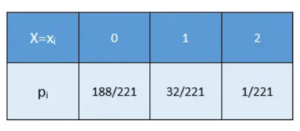
∴ mean, \(\mu=\Sigma x_i p_i=\left(0 \times \frac{188}{221}\right)+\left(1 \times \frac{32}{221}\right)+\left(2 \times \frac{1}{221}\right)=\frac{2}{13}\)
Variance, \(\sigma^2=\Sigma x_i^2 p_i-\mu^2
=\left(0 \times \frac{188}{221}\right)+\left(1 \times \frac{32}{221}\right)+\left(4 \times \frac{1}{221}\right)-\frac{4}{169}\)
=\(\left(\frac{36}{221}-\frac{4}{169}\right)=\frac{400}{2873}\)
Example 7. Three defective bulbs are mixed with 7 good ones. Let X be the number of defective bulbs when 3 bulbs are drawn at random. Find the mean and variance of X.
Solution:
Let X denote the random variable showing the number of defective bulbs.
Then, X can take the value 0,1,2 or 3.
∴ P(X = 0) = P(none of the bulbs is defective)
= P(all the 3 bulbs are good ones)
= \(\frac{{ }^7 C_3}{{ }^{10} C_3}\)=\(\left(\frac{7 \times 6 \times 5}{3 \times 2 \times 1} \times \frac{3 \times 2 \times 1}{10 \times 9 \times 8}\right)\)=\(\frac{7}{24}\).
P(X=1)=P(1 defective and 2 non-defective bulbs)
= \(\frac{{ }^3 C_1 \times{ }^7 C_2}{{ }^{10} C_3}=\left(3 \times \frac{7 \times 6}{2 \times 1} \times \frac{3 \times 2 \times 1}{10 \times 9 \times 8}\right)=\frac{21}{40}\).
P(X=2)=P(2 defective and 1 good one)
= \(\frac{{ }^3 C_2 \times{ }^7 C_1}{{ }^{10} C_3}=\left(\frac{3 \times 2}{2 \times 1} \times 7 \times \frac{3 \times 2 \times 1}{10 \times 9 \times 8}\right)=\frac{7}{40}\).
P(X=3)=P(3 defective bulbs)
= \(\frac{{ }^3 C_3}{{ }^{10} C_3}=\left(1 \times \frac{3 \times 2 \times 1}{10 \times 9 \times 8}\right)=\frac{1}{120}\).
Thus, the probability distribution is given by
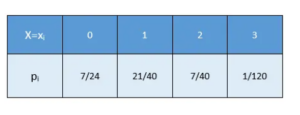
∴ mean, \(\mu=\Sigma x_i p_i=\left(0 \times \frac{7}{24}\right)+\left(1 \times \frac{21}{40}\right)+\left(2 \times \frac{7}{40}\right)+\left(3 \times \frac{1}{120}\right)=\frac{9}{10}\)
Variance, \(\sigma^2=\Sigma x_i^2 p_i-\mu^2\)
= \(\left(0 \times \frac{7}{24}\right)+\left(1 \times \frac{21}{40}\right)+\left(4 \times \frac{7}{40}\right)+\left(9 \times \frac{1}{120}\right)-\frac{81}{100}\)
= \(\left(\frac{13}{10}-\frac{81}{100}\right)=\frac{49}{100}\).
Example 8. An urn contains 4 white and 3 red balls. Let X be the number of red balls in a random draw of 3 balls. Find the mean and variance of X.
Solution:
When 3 balls are drawn at random, there may be no red ball, 1 red ball, 2 red balls or 3 red balls.
Let X denote the random variable showing the number of red balls in a draw of 3 balls.
Then, X can take the value 0,1,2 or 3.
P(X=0) =P(getting no red ball)
= P(getting 3 white balls)
= \(\frac{{ }^4 C_3}{{ }^7 C_3}=\left(\frac{4 \times 3 \times 2}{3 \times 2 \times 1} \times \frac{3 \times 2 \times 1}{7 \times 6 \times 5}\right)=\frac{4}{35}\)
P(X=1)=P(getting 1 red and 2 white balls)
= \(\frac{{ }^3 C_1 \times{ }^4 C_2}{{ }^7 C_3}=\left(\frac{3 \times 4 \times 3}{2} \times \frac{3 \times 2 \times 1}{7 \times 6 \times 5}\right)=\frac{18}{35} \)
P(X=2) =P(\text { getting } 2 \text { red and } 1 \text { white ball })
= \(\frac{{ }^3 C_2 \times{ }^4 C_1}{{ }^7 C_3}=\left(\frac{3 \times 2}{2 \times 1} \times 4 \times \frac{3 \times 2 \times 1}{7 \times 6 \times 5}\right)=\frac{12}{35}\)
P(X=3)=P(getting 3 red balls)
= \(\frac{{ }^3 C_3}{{ }^7 C_3}=\frac{1 \times 3 \times 2 \times 1}{7 \times 6 \times 5}=\frac{1}{35}\).
Thus, the probability distribution of X is given below.
Class 12 Maths Probability Distribution Mean And Variance Of An Urn Contains 4 White And 3 red Balls
∴ mean, \(\mu=\Sigma x_i p_i=\left(0 \times \frac{4}{35}\right)+\left(1 \times \frac{18}{35}\right)+\left(2 \times \frac{12}{35}\right)+\left(3 \times \frac{1}{35}\right)=\frac{9}{7}\)
Variance, \(\sigma^2=\Sigma x_i^2 p_i-\mu^2\)
= \(\left[\left(0 \times \frac{4}{35}\right)+\left(1 \times \frac{18}{35}\right)+\left(4 \times \frac{12}{35}\right)+\left(9 \times \frac{1}{35}\right)-\frac{81}{49}\right]\)
= \(\left(\frac{15}{7}-\frac{81}{49}\right)=\frac{24}{49}\)
Example 9. In a game, 3 coins are tossed. A person is paid Rs 5 if he gets all heads or all tails and he is supposed to pay Rs 3 if he gets one head or two heads. What can he expect to win on an average per game?
Solution:
In tossing 3 coins, the sample space is given by
S = {HHH, HHT, HTH, THH, HTT, THT, TTH, TTT}.
∴ n(S) = 8.
P(getting all heads or all tails) = \(\frac{2}{8}\)=\(\frac{1}{4}\)
P(getting one head or 2 heads) = \(\frac{6}{8}\)=\(\frac{3}{4}\)
Let X = the number of rupees the person gets.
Then, possible values of X are 5 and -3.
P(X=5) = \(\frac{1}{4}\) and P(X=-3) = \(\frac{3}{4}\)
Thus, we have

∴ the required expectations = mean, \(\mu=\Sigma x_i p_i \)
= \(\left(5 \times \frac{1}{4}\right)+(-3) \times \frac{3}{4}=-1\),
i.e., he loses Re 1 per toss.
Probability Distribution Exercise
Question 1. Find the mean (μ), variance (σ²), and standard deviation (σ) for each of the following probability distributions:
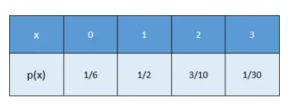
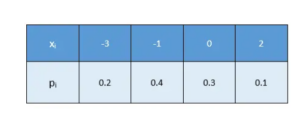

Solution:
Mean =1.5, variance=0.56, SD = 0.74
Mean =2, variance=1, SD =1
Mean = -0.8, variance=2.6, SD = 1.612
Mean = 0, variance=1.2, SD=1.095
Question 2. Find the mean and variance of the number of heads when two coins are tossed simultaneously.
Solution: Mean =1, variance=0.5
Hint: S = {HH, HT, TH, TT}.
Let X be the number of heads. Then, X= 0,1 or 2.
P(X= 0) = P(getting no head) = \(\frac{1}{4}\)
P(X= 1) =P(getting1 head) = \(\frac{2}{4}\) = \(\frac{1}{2}\)
P(X= 2) = P(getting 2 heads) = \(\frac{1}{4}\)

Question 3. Find the mean and variance of the number of tails when three coins are tossed simultaneously.
Solution: Mean =1.5, variance=0.75
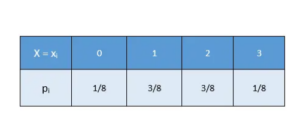
Question 4. A die is tossed twice. ‘Getting an odd number on a toss’ is considered a success. Find the probability distribution of a number of successes. Also, find the mean and variance of the number of successes.
Solution: Mean =1, variance=0.5
Hint: In a single toss,
P(success) = P(getting an odd number) = \(\frac{3}{6}\) = \(\frac{1}{2}\), and
P(non-success) = (1-\(\frac{1}{2}\)) = \(\frac{1}{2}\)
Let X be the number of successes. Then, X= 0,1 or 2.
P(X= 0) = P[(non-successin the 1st toss and non-successin the 2nd)]
= \(\left(\frac{1}{2} \times \frac{1}{2}\right)=\frac{1}{4}\).
P(X=1)- P[(successin the 1st toss and non-success in the 2nd) or (non-success in 1st toss and success in the 2nd)]
= \(\left(\frac{1}{2} \times \frac{1}{2}\right)+\left(\frac{1}{2} \times \frac{1}{2}\right)=\frac{1}{2}\)
P(X=2) =P[success in the 1 st toss and success in the 2nd]
= \(\left(\frac{1}{2} \times \frac{1}{2}\right)=\frac{1}{4}\).

Question 5. A die is tossed twice. ‘Getting a number greater than 4’ is considered a success. Find the probability distribution of a number of successes. Also, find the mean and variance of the number of successes.
Solution: Mean=\(\frac{2}{3}\), variance=\(\frac{4}{9}\)
In a single toss, P(success) = and P(non-success) = (1-\(\frac{1}{3}\)) = \(\frac{2}{3}\)
P(X = 0) = P(non-success in the 1st draw and non-success in the second)
= \(\left(\frac{2}{3} \times \frac{2}{3}\right)=\frac{4}{9} \text {. }\)
P(X=1) = P(success in the ls.t toss and non-success in the 2nd) or ( non-success in the 1st toss and success in the 2nd)]
= \(\left(\frac{1}{3} \times \frac{2}{3}\right)+\left(\frac{2}{3} \times \frac{1}{3}\right)=\frac{4}{9}\)
P(X = 2) = P[(success in the 1st toss and success in the 2nd)]
= \(\left(\frac{1}{3} \times \frac{1}{3}\right)=\frac{1}{9}\).

Question 6. A pair of dice is thrown 4 times. If getting a doublet is considered a success, find the probability distribution of a number of successes. Also, find the mean and variance of a number of successes.
Solution: Mean=\(\frac{2}{3}\), variance=\(\frac{5}{9}\)
Hint: In a single throw, P(doublet) = 6/36, 1/6, and P(non-doublet) = (1-\(\frac{1}{6}\)) = \(\frac{5}{6}\)
Let X be the number of doublets. Then, X = 0, 1, 2 or 3.
P(X = 0) = P(non-doublet in each case)
= \(P\left(\bar{D}_1 \bar{D}_2 \bar{D}_3 \bar{D}_4\right)=\left(\frac{5}{6} \times \frac{5}{6} \times \frac{5}{6} \times \frac{5}{6}\right)=\frac{625}{1296}\)
P(X=1)= P(one doublet)
= \(P\left(D_1 \bar{D}_2 \bar{D}_3 \bar{D}_4\right) \text { or } P\left(\bar{D}_1 D_2 \bar{D}_3 \bar{D}_4\right) \)
or \(P\left(\bar{D}_1 \bar{D}_2 D_3 \bar{D}_4\right) \text { or } P\left(\bar{D}_1 \bar{D}_2 \bar{D}_3 D_4\right) \)
= \(\left(\frac{1}{6} \times \frac{5}{6} \times \frac{5}{6} \times \frac{5}{6}\right)+\left(\frac{5}{6} \times \frac{1}{6} \times \frac{5}{6} \times \frac{5}{6}\right)+\left(\frac{5}{6} \times \frac{5}{6} \times \frac{1}{6} \times \frac{5}{6}\right)+\left(\frac{5}{6} \times \frac{5}{6} \times \frac{5}{6} \times \frac{1}{6}\right)\)
= \(\left(4 \times \frac{125}{1296}\right)=\frac{125}{324}\)
P(X=2)= P(two doublets)
= \(P\left(D_1 D_2 \bar{D}_3 \bar{D}_4\right) \quad \text { or } P\left(D_1 \bar{D}_2 D_3 \bar{D}_4\right) \text { or } P\left(D_1 \bar{D}_2 \bar{D}_3 D_4\right)\)
or \(P\left(\bar{D}_1 D_2 D_3 \bar{D}_4\right) \text { or } P\left(\bar{D}_1 D_2 \bar{D}_3 D_4\right) \text { or } P\left(\bar{D}_1 \bar{D}_2 D_3 D_4\right)\)
= \(\left(\frac{1}{6} \times \frac{1}{6} \times \frac{5}{6} \times \frac{5}{6}\right)+\left(\frac{1}{6} \times \frac{5}{6} \times \frac{1}{6} \times \frac{5}{6}\right)+\left(\frac{1}{6} \times \frac{5}{6} \times \frac{5}{6} \times \frac{1}{6}\right)\)
+ \(\left(\frac{5}{6} \times \frac{1}{6} \times \frac{1}{6} \times \frac{5}{6}\right)+\left(\frac{5}{6} \times \frac{1}{6} \times \frac{5}{6} \times \frac{1}{6}\right)+\left(\frac{5}{6} \times \frac{5}{6} \times \frac{1}{6} \times \frac{1}{6}\right)\)
= \(\left(6 \times \frac{25}{1296}\right)=\frac{25}{216}\)
P(X=3)= P(three doublets)
= \(P\left(D_1 D_2 D_3 \bar{D}_4\right) \text { or } P\left(D_1 D_2 \bar{D}_3 D_4\right)\)
or \(P\left(D_1 \bar{D}_2 D_3 D_4\right) \text { or } P\left(\bar{D}_1 D_2 D_3 D_4\right)\)
= \(\left(\frac{1}{6} \times \frac{1}{6} \times \frac{1}{6} \times \frac{5}{6}\right)+\left(\frac{1}{6} \times \frac{1}{6} \times \frac{5}{6} \times \frac{1}{6}\right)+\left(\frac{1}{6} \times \frac{5}{6} \times \frac{1}{6} \times \frac{1}{6}\right)+\left(\frac{5}{6} \times \frac{1}{6} \times \frac{1}{6} \times \frac{1}{6}\right)\)
= \(\left(4 \times \frac{5}{1296}\right)=\frac{5}{324} \)
P(X=4)= P(four doublets)=P\left(D_1 D_2 D_3 D_4\right)[/latex]
= \(\left(\frac{1}{6} \times \frac{1}{6} \times \frac{1}{6} \times \frac{1}{6}\right)=\frac{1}{1296}\)
Thus, we have

Question 7. A coin is tossed 4 times. Let X denote the number of heads. Find the probability distribution of X. Also, find the mean and variance of X.
Solution: Mean=2, variance=1
In a single throw of a coin, \(P(H)=\frac{1}{2}\) and \(P(\bar{H})=P(T)=\frac{1}{2}\).
Let X show the number of heads. Then, X=0,1,2,3 or 4 .
P(X=0)=P(no head)=\(P\left(\bar{H}_1 \bar{H}_2 \bar{H}_3 \bar{H}_4\right)=\left(\frac{1}{2} \times \frac{1}{2} \times \frac{1}{2} \times \frac{1}{2}\right)=\frac{1}{16} \text {. }\)
P(X=1)=P(one head)= \(P\left(H_1 \bar{H}_2 \bar{H}_3 \bar{H}_4\right) \text { or }\left(\bar{H}_1 H_2 \bar{H}_3 \bar{H}_4\right)\)
or \(P\left(\bar{H}_1 \bar{H}_2 H_3 \bar{H}_4\right) \text { or } P\left(\bar{H}_1 \bar{H}_2 \bar{H}_3 H_4\right) \)
= \(4\left(\frac{1}{2} \times \frac{1}{2} \times \frac{1}{2} \times \frac{1}{2}\right)=\left(4 \times \frac{1}{16}\right)=\frac{1}{4}\)
P(X=2)=P(two heads)= \(P\left(H_1 H_2 \bar{H}_3 \bar{H}_4\right) \text { or } P\left(H_1 \bar{H}_2 H_3 \bar{H}_4\right)\)
or \(P\left(H_1 \bar{H}_2 \bar{H}_3 H_4\right) \text { or } P\left(\bar{H}_1 H_2 H_3 \bar{H}_4\right)\)
or \(P\left(\bar{H}_1 H_2 \bar{H}_3 H_4\right) \text { or } P\left(\bar{H}_1 \bar{H}_2 H_3 H_4\right)\)
= \(\left(6 \times \frac{1}{16}\right)=\frac{3}{8}\)
P(X=3)=P(\text { three heads })=P\left(H_1 H_2 H_3 \bar{H}_4\right) \text { or }\left(H_1 H_2 \bar{H}_3 H_4\right)[/latex]
or \(P\left(H_1 \bar{H}_2 H_3 H_4\right) \text { or } P\left(\bar{H}_1 H_2 H_3 H_4\right)\)
= \(4 \times\left(\frac{1}{2} \times \frac{1}{2} \times \frac{1}{2} \times \frac{1}{2}\right)=\left(4 \times \frac{1}{16}\right)=\frac{1}{4} \text {. }\)
P(X=4)=P(four heads)= \(P\left(H_1 H_2 H_3 H_4\right)=\left(\frac{1}{2} \times \frac{1}{2} \times \frac{1}{2} \times \frac{1}{2}\right)=\frac{1}{16}\).
Thus, we have
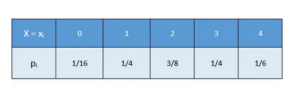
Question 8. Let X denote the number of times ‘a total of 9’ appears in two throws of a pair of dice. Find the probability distribution of X. Also, find the mean, variance, and standard deviation of X.
Solution: Mean=\(\frac{2}{9}\), variance=\(\frac{16}{81}\), SD = \(\frac{4}{9}\)
Hint: Let E={(3,6),(6,3),(4,5),(5,4)}. So, n(E)=4.
∴ P(E)= \(\frac{4}{36}=\frac{1}{9}\), and \(P(\bar{E})=\left(1-\frac{1}{9}\right)=\frac{8}{9}\).
Let X be the number of times ‘a total of 9’ appears in 2 throws Then, X=0, 1 or 2.
P(X=0)= \(=P\left(\bar{E}_1 \bar{E}_2\right)=\left(\frac{8}{9} \times \frac{8}{9}\right)=\frac{64}{81}\)
P(X=1)= \(P\left[\left(E_1 \bar{E}_2\right) \text { or }\left(\bar{E}_1 E_2\right)\right]=P\left(E_1 \bar{E}_2\right)+P\left(\bar{E}_1 E_2\right)\)
= \(\left(\frac{1}{9} \times \frac{8}{9}\right)+\left(\frac{8}{9} \times \frac{1}{9}\right)=\frac{16}{81}\)
P(X=2)= \(P\left(E_1 E_2\right)=P\left(E_1\right) \times P\left(E_2\right)=\left(\frac{1}{9} \times \frac{1}{9}\right)=\frac{1}{81}\)
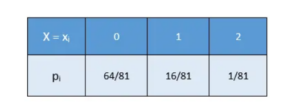
Question 9. There are 5 cards, numbered 1 to 5, with one number on each card. Two cards are drawn at random without replacement. Let X denote the sum of the numbers on the two cards drawn. Find the mean and variance of X.
Solution: Mean=6, variance=3
Hint: S ={(1, 2), (1, 3), (1, 4), (1, 5), (2, 1), (2, 3), (2, 4), (2, 5), (3, 1), (3, 2), (3, 4), (3, 5),
(4, 1), (4, 2), (4, 3), (4, 5), (5, 1), (5, 2), (5, 3), (5, 4)}
Then X = 3, 4, 5, 6, 7, 8 and 9.
P(X=3)=\(\frac{2}{20}\)=\(\frac{1}{10}\);
P(X=4)=\(\frac{2}{10}\)=\(\frac{1}{10}\)
P(X=5)=\(\frac{4}{20}\)=\(\frac{1}{5}\)
P(X=6)=\(\frac{4}{20}\)=\(\frac{1}{5}\)
P(X=7)=\(\frac{4}{20}\)=\(\frac{1}{5}\)
P(X=8)=\(\frac{2}{20}\)=\(\frac{1}{10}\)
P(X=9)=\(\frac{2}{20}\)=\(\frac{1}{10}\)
Thus, we have

Question 10. Two cards are drawn from a well-shuffled pack of 52 cards. Find the probability distribution of a number of kings. Also, compute the variance for the number of kings.
Solution: Variance=\(\frac{400}{2873}\)
Hint: Let X be the number of kings. Then, X = 0,1 or 2.
P(X = 0) = P(none is a king) = P(both are non-kings)
= \(\frac{{ }^{48} C_2}{{ }^{52} C_2}=\left(\frac{48 \times 47}{2} \times \frac{2}{52 \times 51}\right)=\frac{188}{221} .\)
P(X = 1) = P(one king and one non-king)
= \(\frac{{ }^4 C_1 \times{ }^{48} C_1}{{ }^{52} C_2}=\left(4 \times 48 \times \frac{2}{52 \times 51}\right)=\frac{32}{221} .\)
P(X = 2) = P(both are kings)
= \(\frac{{ }^4 C_2}{{ }^{52} C_2}=\left(\frac{4 \times 3}{2 \times 1} \times \frac{2 \times 1}{52 \times 51}\right)=\frac{1}{221}\)
Thus, we have
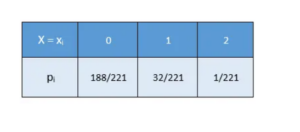
Question 11. A box contains 16 bulbs, out of which 4 bulbs are defective. Three bulbs are drawn at random from the box. Let X be the number of defective bulbs drawn. Find the mean and variance of X.
Solution: Mean=\(\frac{3}{4}\), variance=\(\frac{39}{80}\)
Hint: Three bulbs drawn one by one without replacement is the same as drawing 3 bulbs simultaneously.
Let X = number of defective bulbs in a lot of 3 bulbs drawn.
Then, X = 0, 1, 2 or 3.
P(X = 0) = P(none of the bulbs is defective)
= \(\frac{{ }^{12} C_3}{{ }^{16} C_3}=\left(\frac{12 \times 11 \times 10}{3 \times 2 \times 1} \times \frac{3 \times 2 \times 1}{16 \times 15 \times 14}\right)=\frac{11}{28}\)
P(X=1)=P(1 defective bulb and 2 non-defective bulbs)
= \(\frac{{ }^4 C_1 \times{ }^{12} C_2}{{ }^{16} C_3}=\left(\frac{4 \times 12 \times 11}{2 \times 1} \times \frac{3 \times 2 \times 1}{16 \times 15 \times 14}\right)=\frac{33}{70}\)
P(X=2)=P(2 defective bulbs and 1 non-defective bulb)
= \(\frac{\left({ }^4 C_2 \times{ }^{12} C_1\right)}{{ }^{16} C_3}=\left(\frac{4 \times 3}{2 \times 1} \times 12 \times \frac{3 \times 2 \times 1}{16 \times 15 \times 14}\right)=\frac{9}{70}\).
P(X=3)=P(3 defective bulbs)
= \(\frac{{ }^4 C_3}{{ }^{16} C_3}=\left(\frac{4 \times 3 \times 2}{3 \times 2 \times 1} \times \frac{3 \times 2 \times 1}{16 \times 15 \times 14}\right)=\frac{1}{140}\).

Question 12. 20% of the bulbs produced by a machine are defective. Find the probability distribution of the number of defective bulbs in a sample of 4 bulbs chosen at random.
Solution:
Let there be 100 bulbs in all and let X be the number of defective bulbs. Then,
P(X = 0) = P(none is defective) = \(=\frac{{ }^{80} C_4}{{ }^{100} C_4} .\)
P(X = 1) = P(1 defective and 3 non-defective)
= \(\frac{\left({ }^{20} C_1 \times{ }^{00} C_3\right)}{{ }^{100} C_4}\)
P(X=2)= \(\frac{\left({ }^{20} C_2 \times{ }^{80} C_2\right)}{{ }^{100} C_4} ; P(X=3)=\frac{\left({ }^{20} C_3 \times{ }^{80} C_1\right)}{{ }^{100} C_4} ; P(X=4)=\frac{{ }^{20} C_4}{{ }^{100} C_4}\)
Question 13. Four bad eggs are mixed with 10 good ones. Three eggs are drawn one by one without replacement. Let X be the number of bad eggs drawn. Find the mean and variance of X.
Solution: Mean=\(\frac{6}{7}\), variance=\(\frac{30}{49}\)
Question 14. Four rotten oranges are accidentally mixed with 16 good ones. Three oranges are drawn at random from the mixed lot. Let X be the number of rotten oranges drawn. Find the mean and variance of X.
Solution: Mean=\(\frac{3}{5}\), variance=\(\frac{68}{125}\)
Question 15. Three balls are drawn simultaneously from a bag containing 5 white and 4 red balls. Let X be the number of red balls drawn. Find the mean and variance of X.
Solution: Mean=\(\frac{4}{3}\), variance=\(\frac{5}{9}\)
Hint:
P(X=0)= \(\frac{{ }^5 C_3}{{ }^9 C_3}=\frac{5}{42}, P(X=1)=\frac{\left({ }^4 C_1 \times{ }^5 C_2\right)}{{ }^9 C_3}=\frac{10}{21},\)
P(X=2)=\(\frac{\left({ }^4 C_2 \times{ }^5 C_1\right)}{{ }^9 C_3}=\frac{5}{14}, P(X=3)=\frac{{ }^4 C_3}{{ }^9 C_3}=\frac{1}{21}\).
Question 16. Two cards are drawn without replacement from a well-shuffled deck of 52 cards. Let X be the number of face cards drawn. Find the mean and variance of X.
Solution: Mean=\(\frac{20}{13}\), variance=\(\frac{1000}{2873}\)
Hint: There are 12 face cards (4 kings, 4 queens and 4 jacks).
Clearly, X = 0 or 1 or 2.
P(X = 0) = P(no face card)
= P(drawing 2 cards out of 40 non-face cards)
= \(\frac{{ }^{40} C_2}{{ }^{52} C_2}=\left(\frac{40 \times 39}{2 \times 1} \times \frac{2 \times 1}{52 \times 51}\right)=\frac{10}{17}\)
P(X=1)=P(1 face card and 1 non-face card)
= \(\frac{\left({ }^{12} C_1 \times{ }^{40} C_1\right)}{{ }^{52} C_2}=\left(12 \times 40 \times \frac{2 \times 1}{52 \times 51}\right)=\frac{80}{221}\).
P(X=2)=P(2 face cards)
= \(\frac{{ }^{40} C_2}{{ }^{52} C_2}=\left(\frac{40 \times 39}{2 \times 1} \times \frac{2 \times 1}{52 \times 51}\right)=\frac{10}{17}\)
Thus, we have
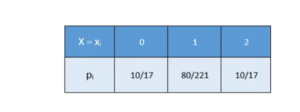
Question 17. Two cards are drawn one by one with replacement from a well-shuffled deck of 52 cards. Find the mean and variance of the number of aces.
Solution: Mean=\(\frac{2}{13}\), variance=\(\frac{24}{169}\)
Question 18. Three cards are drawn successively with replacement from a well-shuffled deck of 52 cards. A random variable X denotes the number of hearts in the three cards drawn. Find the mean and variance of X.
Solution: Mean=\(\frac{3}{4}\), variance=\(\frac{9}{16}\)
Hint: There are 13 hearts and 39 other cards.
Let E = event of drawing a heart.
Then, \(P(E)=\frac{13}{52}=\frac{1}{4} \text { and } P(\bar{E})=\left(1-\frac{1}{4}\right)=\frac{3}{4}\)
Let X = number of hearts in a draw.
Then, X = 0,1, 2 or 3.
P(X=0)=\(P(\bar{E} \bar{E} \bar{E})=P(\bar{E}) \times P(\bar{E}) \times P(\bar{E})=\left(\frac{3}{4} \times \frac{3}{4} \times \frac{3}{4}\right)=\frac{27}{64}\)
P(X=1)=\(P[(E \bar{E} \bar{E}) \text { or }(\bar{E} E \bar{E}) \text { or }(\bar{E} \bar{E} E)]\)
= \(P(E \bar{E} \bar{E})+P(\bar{E} E \bar{E})+P(\bar{E} \bar{E} E)\)
= \(\left(\frac{1}{4} \times \frac{3}{4} \times \frac{3}{4}\right)+\left(\frac{3}{4} \times \frac{1}{4} \times \frac{3}{4}\right)+\left(\frac{3}{4} \times \frac{3}{4} \times \frac{1}{4}\right)=\frac{27}{64}\)
P(X=2)= \(P[(E E \bar{E}) \text { or }(E \bar{E} E) \text { or }(\bar{E} E E)]\)
= \(P(E E \bar{E})+P(E \bar{E} E)+P(\bar{E} E E)\)
= \(\left(\frac{1}{4} \times \frac{1}{4} \times \frac{3}{4}\right)+\left(\frac{1}{4} \times \frac{3}{4} \times \frac{1}{4}\right)+\left(\frac{3}{4} \times \frac{1}{4} \times \frac{1}{4}\right)=\frac{9}{64}\)
P(X=3) = \(P(E E E)=P(E) \times P(E) \times P(E)=\left(\frac{1}{4} \times \frac{1}{4} \times \frac{1}{4}\right)=\frac{1}{64}\)
